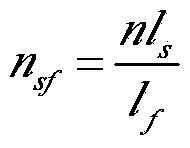Method for predicting limit unevenness of resultant yarn by simulating random arrangement of equal-fineness fibers in single yarn
A technology of random arrangement and fibers, applied in textiles and papermaking, etc., can solve the problems of not given fiber arrangement and uncontrollable actual number of fibers, and achieve the effect of avoiding calculation
- Summary
- Abstract
- Description
- Claims
- Application Information
AI Technical Summary
Problems solved by technology
Method used
Image
Examples
Embodiment Construction
[0023] Below in conjunction with specific embodiment, further illustrate the present invention. It should be understood that these examples are only used to illustrate the present invention and are not intended to limit the scope of the present invention. In addition, it should be understood that after reading the teachings of the present invention, those skilled in the art can make various changes or modifications to the present invention, and these equivalent forms also fall within the scope defined by the appended claims of the present application.
[0024] The embodiment of the present invention relates to a method for simulating the random arrangement of fibers of equal fineness in a single yarn to predict the limit unevenness of yarn formation. For the simulated single yarn generated by these fiber arrangements, the length of each sub-segment in the simulated yarn is calculated by computer programming. The total length of the fibers contained in the segment, so that the ...
PUM
 Login to View More
Login to View More Abstract
Description
Claims
Application Information
 Login to View More
Login to View More - R&D
- Intellectual Property
- Life Sciences
- Materials
- Tech Scout
- Unparalleled Data Quality
- Higher Quality Content
- 60% Fewer Hallucinations
Browse by: Latest US Patents, China's latest patents, Technical Efficacy Thesaurus, Application Domain, Technology Topic, Popular Technical Reports.
© 2025 PatSnap. All rights reserved.Legal|Privacy policy|Modern Slavery Act Transparency Statement|Sitemap|About US| Contact US: help@patsnap.com



